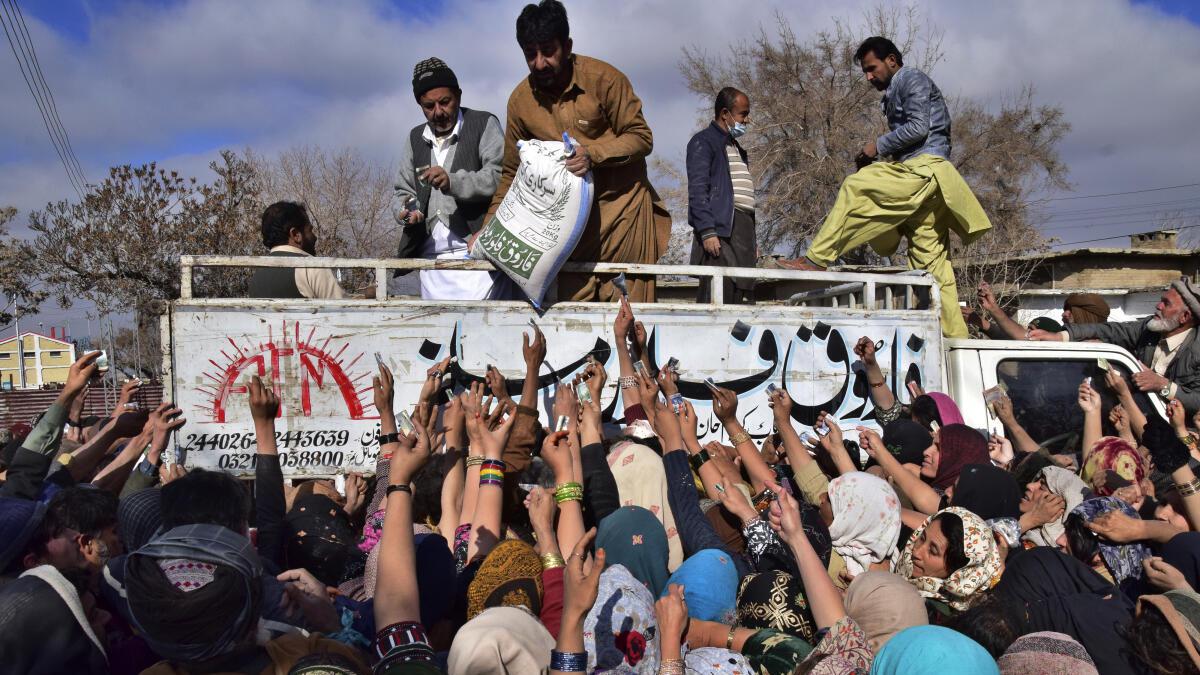Why Pakistan’s economy is collapsing? Explained in charts

People jostle to buy subsidized sacks of wheat flour from a sale point in Quetta, Pakistan. People are suffering from recent price hike in wheat-flour in Pakistan.
| Photo Credit: AP/Arshad Butt
Pakistan’s economy is on the brink of collapse. The country has asked the International Monetary Fund for a bailout from an impending default. Pakistan is in its 13th bailout from the IMF since the late 1980s. It is grappling with widespread blackouts, runaway inflation, depreciating currency and plummeting foreign exchange reserves. Its economic troubles have worsened following the devastating floods last year. In January 2023, retail inflation soared to a 48-year-high of 27.6%. Urban food inflation was at 39% while rural food inflation spiralled to 45.2%. Both urban and rural food inflation have remained in double digits for over10 months now. Chart 1 shows general retail inflation and food inflation in urban and rural areas (in %).
Chart appears incomplete? Click to remove AMP mode
Rising inflationary pressure has pushed up the prices of essential commodities like wheat, onions, milk and egg. The average cost of a 20kg wheat flour bag in January 2022 was Pakistani Rupee (PKR) 1,164.8. This shot up to PKR 1,736.5 in January 2023, a 50% rise. Similarly, the price of one kg of onions quintupled from PKR 39.4 to PKR 231 in a span of one year. Chart 2 shows the prices (in PKR) of essential commodities during January in the past five years.
Meanwhile, news reports suggest that thousands of containers with essential food items, raw materials and medical equipment are held up at ports due to a shortage of dollars. Foreign exchange reserves with the State Bank of Pakistan dipped to $3.08 billion in the week ending January 27, 2023. Forex reserves in Pakistan have dwindled to a nine-year low and are just enough to cover three weeks of import. Chart 3 shows the week-wise foreign exchange reserves (in $ billion) held by Pakistan’s central bank.
Depreciating currency and dwindling forex reserves are bound to make imports costly, which is worrying for Pakistan since it is highly reliant on imports. While the country’s imports have seen a significant rise, exports have remained largely stagnant, widening the trade deficit in the recent years. According to a working paper by the Asian Development Bank, Pakistan did not produce machinery crucial for manufacturing and infrastructure development, which made them import reliant. Pakistan’s exports mainly comprise textiles and agriculture-related goods and lack technological sophistication. However, in the past few months, imports, too, have reduced due to a shortage of dollars. Chart 4 shows the year-wise value of export and import of goods in $ million.
Pakistan’s expenses are also rising while revenues have failed to keep pace. Interest payments comprise a huge chunk of expenses leaving little room for development-related expenditure. At the same time, Pakistan has also not been able to mobilise tax revenues due to a narrow tax base and concessions. In FY22, total revenues as a share of GDP decreased to 12% while total expenditure as a share of GDP neared 20%. Chart 5 shows the share of total revenue and total expenditure in the GDP.
Due to high levels of borrowing, total debt and liabilities reached PKR 59,697.7 billion (89% of the GDP) in FY22. Total debt has consistently risen over the years and peaked at 93.8% in FY20. Of the total outstanding bilateral debt owed by Pakistan as of March 2022, China accounts for about 35%. Moreover, a sector-wise share of foreign private debt shows that as much as 92% was used for the power sector. Chart 6 shows financial year-wise Pakistan’s total debt and liabilities in billion PKR (left axis). It also plots the share of total debt as a % of the GDP (right axis).
Source: State Bank of Pakistan, Economic Affairs Division of Pakistan, Pakistan Bureau of Statistics and Asian Development Bank
Also read : Data | After 2019, Pakistan reduced dependency on India by importing from China and Brazil
For all the latest business News Click Here

